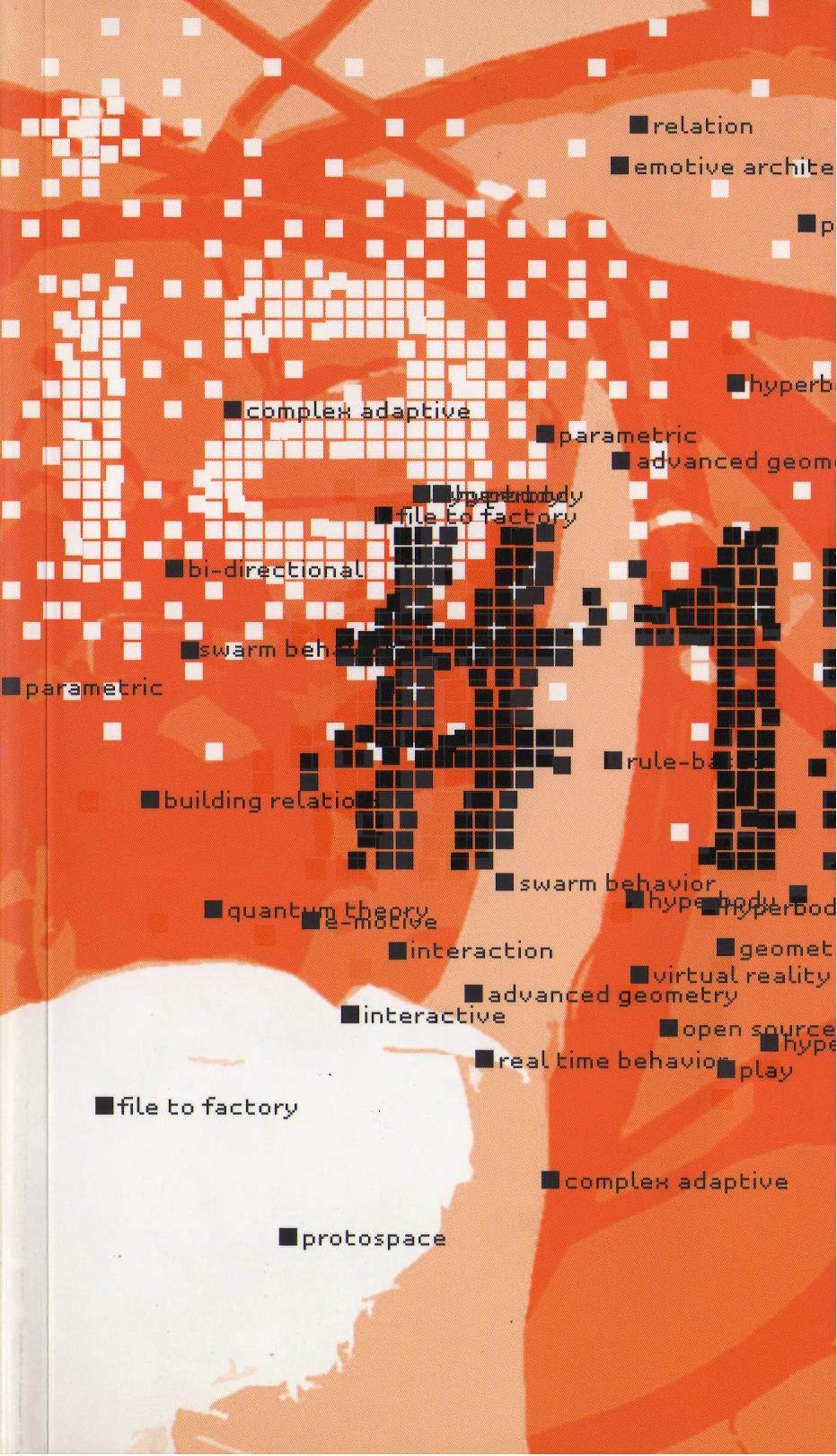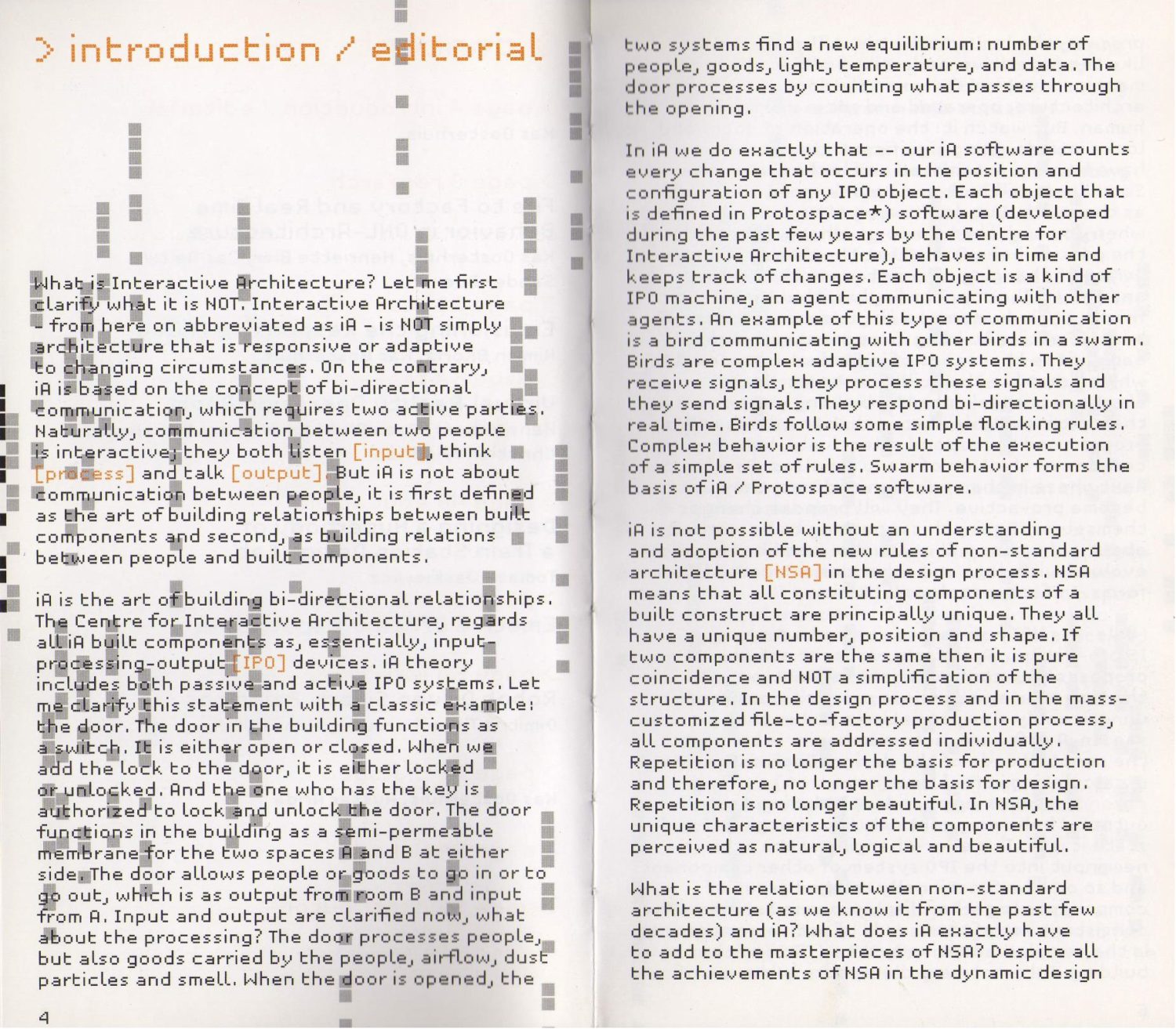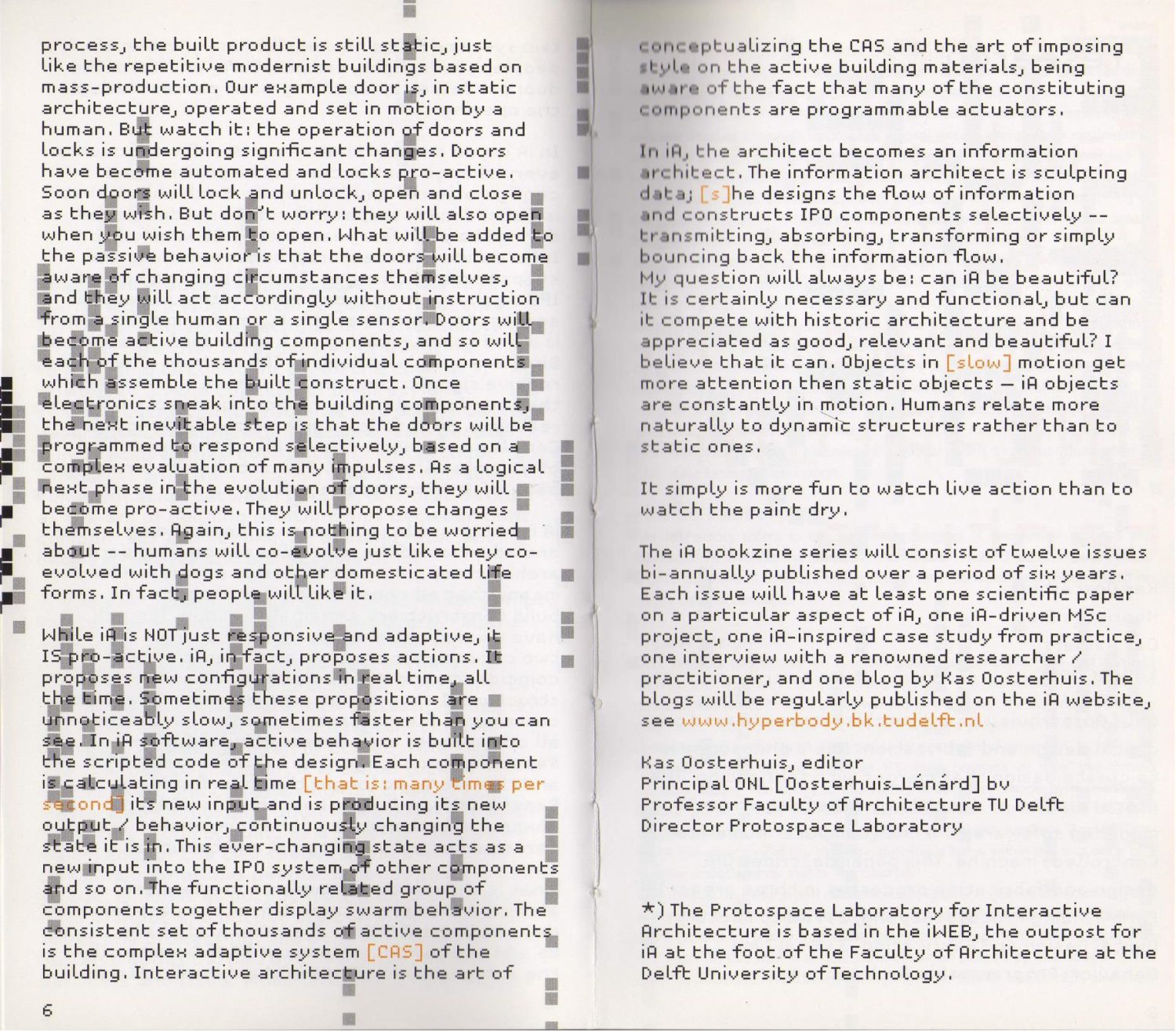iA#1 | iA#2 | iA#3 |iA#4 | iA#5

Flashback 2007 | iA#1 Introduction / editorial
Below is the text of the introduction that I wrote for iA#1, the first in a series of 5 iA bookzines [Interactive Architecture], to report on the innovative work at Hyperbody TU Delft. The iA#1 Introduction is written in 2007. iA#1 ISBN 9789059730588 is available at Episode Publishers / Jap Sam Books]:
https://nl.japsambooks.nl/collections/architectuur?page=4

What is Interactive Architecture?
Let me first clarify what is NOT. Interactive Architecture – from here on abbreviated as iA – is NOT simply architecture that is responsive or adaptive to changing circumstances. On the contrary, iA is based on the concept of bi-directional communication, which requires two active parties. Naturally, communication between two people is interactive, they both listen [input], think [process] and talk [output]. But iA is not about communication between people, it is 1] defined as the art of building relationships between built components and 2] as building relations between people and built components.
iA is the Art of Bi-directional Relationships
The Center for Interactive Architecture [CIA], Hyperbody’s research center, regards all iA built components as, essentially, input – processing – output [IPO] devices. iA theory includes both passive and active IPO systems. Let me clarify this with a classic example: the door. The door in the building functions as a switch. The door is either open or closed. When we add a lock to the door, it is either locked or unlocked. and the one who has the key is authorized to lock and unlock the door. The door functions in the building as a semipermeable membrane for the two spaces A and B at either side. The door allows people or goods to go in or to go out, which is as output from room B and input from A. Input and output are clarified now, what about the processing? The door processes people but also goods carried by the people, airflow, dust particles and smell. When the door is opened, the two systems find a new equilibrium: number of people, goods, light, temperature, and data. The door processes by counting what passes through the opening.
Input Processing Output Machine
In iA we do exactly that our iA software counts every change that occurs in the position and configuration of any IPO object. Each object that is defined in Protospace software [developed during the past few years in our CIA, behaves in time and keeps track of change. Each object is a kind of IPO machine, an agent communicating with other agents. An example of this type of communication is a bird communicating with other birds in a swarm. Birds are complex adaptive IPO systems, They receive signals and they send signals. They respond bi-directional in real time. birds follow some simple set of rules. Swarm behavior forms the basis of iA / Protospace software.
Repetition No Longer Beautiful
iA is not possible without an understanding and adoption of the new rules of nonstandard architecture [NSA] in the design process. NSA means that all constituting components of a built construct are principally unique. They all have a unique number, position and shape. If two components are the same then it is pure coincidence and NOT a simplification of the structure. In the design process and in the mass-customized file-to-factory production process, all components are addressed individually. Repetition is no longer the basis for production and therefore, no longer the basis for design. Repetition is no longer beautiful. In NSA, the unique characteristics of the components are perceived as natural, logical and beautiful.

Proactive Building Components
What is the relation between nonstandard architecture [as we know it from the past decades] and iA? What does iA exactly has to add to the masterpieces of NSA? Despite all the achievements of NSA in the dynamic design process, the built product is still static, just like the repetitive modernist buildings based on mass-production. Our exemplary door is, in static architecture, operated and set in motion by a human. But watch it: the operation of doors and locks is undergoing significant changes. Doors have become automated and and locks pro-active. Soon doors and locks will open and close as they wish. But don’t worry: they will also open when YOU wish them to open. What will added to a passive behavior of is that the door will become aware of changing circumstances themselves, and they will act accordingly without instruction from a single human or a single sensor. Doors will become active building components, and so will each of the thousands of individual components, which assemble the built construct. Once electronics sneak into the building components, the next inevitable step is the doors will be programmed to respond selectively, based on a complex evaluation of many impulses. As a logical next phase in the evolution of doors, they will become proactive. They will propose changes themselves. Again, this is nothing to be worried about, humans will co-evolve like they co-evolved with dogs and other domesticated life forms. In fact, people will like it.
Complex Adaptive System
While iA is NOT just responsive and adaptive, it IS proactive. iA, in fact, proposes actions. it proposes new configurations in real time, all the time. Sometimes these propositions are unnoticeable slow, sometimes faster than you can see. In iA software, active behavior is built into the scripted code of the design. Each component is calculating in real time [that is, many times per second] its input and is producing its new output / behavior,continuously changing the state it is in. This ever-changing state acts as a new input into the IPO system of other components and so on. The functionally related group of components together display swarm behavior. The consistent set of thousands of active components is the complex adaptive system [CAS] of the building. Interactive architecture is the art of conceptualizing the CAS and the art of imposing style on the active building materials, being aware of the fact that many of the constituting components are programmable actuators.
The Information Architect
In iA, the architect becomes an information architect. The information architect is sculpting data. [S]he designs the flow of information and constructs IPO components selectively – transmitting, absorbing, transforming or simply bouncing back the information flow. My question will always be: c an iA be beautiful? I believe that it can. Object in [slow] motion get more attention than static objects – iA object are constantly in motion. Humans relate more to dynamic structures rather than static ones. It is simply more fun to watch live action than to watch paint dry.
Post Scriptum
The iA bookzine series was intended to consist of twelve issues bi-annually published over a period of 6 years. Each issue would have at least one scientific paper on a particular aspect of iA, one iA-driven MSc project, one iA-inspired case study from practice, one interview with a renowned researcher / practitioner, and a blog by myself. The blogs would be regularly published on the iA website. Eventually, Hyperbody published 5 iA bookzines between 2007 and 2013. Now, 12 years later, lest we forget, I will publish the introductions of the 5 iA bookzines here on this site in 5 consecutive blogs.
Kas Oosterhuis, editor iA bookzine series | Principal ONL [Oosterhuis_Lénárd] bv | Emeritus Professor Faculty of Architecture TU Delft [2000 – 2016]| Director Protospace Laboratory 2003 – 2016
